It’s that time of year again, the time when hop rhizomes are available for homebrewers who wish to grow hops. Growing your own hops can be very rewarding. It’s also very straightforward. Here’s what you need to plant hops for your own “beer garden.”
Location
In most growing regions, hops will do best where they receive full sun. If you live in a very hot climate, some shade during the hottest part of the day can be a good thing. Pick a sunny day and walk around your house several different times during the day. Look for locations that receive sun from sunrise to sunset. Hops also require good drainage, so rule out locations where water collects after it rains.
Trellising
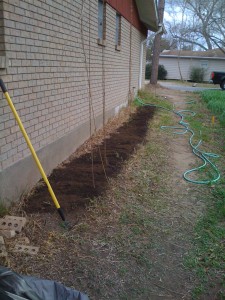
Planting hops on the sunny side of a house. A trench is dug and the soil is blended with compost. Hop trellis twine hangs from the roof, ready to accept the bines.
Before you plant your hops, decide on the type of trellis you will use to support them. Hops can grow up to 30 feet (9 m), and they need support to do this. The easiest kind of trellis to construct is simply twine hanging from a eye hook screwed into the roofline of your house. Free-standing poles or lattices will also work for trellising. It’s best to install your trellis at the same time you plant your hops. This way you won’t damage the plants when you install the trellis.
Varieties
Commercially, most hops are grown between the 35th and 55th parallel (in both the Southern and Northern Hemisphere). If you are within these latitudes, you can grow almost any hop variety successfully. If you live in a warmer climate, varieties such as Cascade or any of the high-alpha American varieties are a good choice. Delicate aroma hops tend to grow weakly and wither in hot climates.
Receiving the Rhizomes
If your rhizomes arrive before you can plant them, store them in your refrigerator. Wrap the rhizomes in wet newspaper and avoid stacking anything on top of them. If they are in a plastic bag, leave the bag open or punch air holes in it. Wait until all threat of frost is gone before planting the rhizomes.
Soil Preparation
Hops are very hardy and will grow in almost any reasonably fertile soil. To give first year hops a good start, dig a roughly basketball-sized hole and blend the dirt from the hole with roughly the same volume of compost or composted manure. Avoid over-fertilizing first year hops. You want to stimulate the plants to send out roots as far as possible. If the hop leaves turn yellow during the growing season, add a small amount of plant fertilizer. If not, just let the plants establish themselves in the first year. The compost should provide enough nutrition for them during this period.
Planting
Hop rhizomes are underground stems. Hops are propagated by planting these rhizomes, that will sprout roots and vines when the conditions are right. Any hop rhizomes you buy will be female. Male hop plants are not cultivated.
Your rhizome will likely be at least roughly the size and shape of a pencil. To plant the rhizome, fill the basketball-sized hole you dug with your mixture of compost and dirt. Lay the rhizome on top of this mix, then pile more dirt-and-compost mixture on top of the rhizome until it is covered by 1–2 inches of the mix. This will result in a small hill, with the rhizome placed at roughly ground level. (It is also OK for the rhizome to be slightly below ground level, especially if your drainage is good.)
Water the ground around the rhizome thoroughly. Do not water again until the top half inch or so of soil has dried. When it’s time to water, soak the area well. Watering deeply, followed by letting the soil almost dry out, stimulates the growth of roots.
Sprouting
Eventually, you will see hop shoots emerge from the soil. These will grow several inches tall before they need to be supported. When the shoots are long enough, train them to the twine from the trellis. Hop bines grow in a clockwise manner around the twine, if you are looking down on them. (The particular type of vine that hops produce is called a bine.) However, do not worry if you accidentally train them counterclockwise. The bines will simply start growing clockwise matter.
For first-year hops, you should train as many shoots as you can, so long as each bine can grow without crowding the others. If if the bines get too crowded, and air cannot flow around them, moisture can get trapped and potentially lead to problems with mildew.
Hop To It
Growing hops is easy. If you plant them in well-drained, reasonably fertile soil, in a location with full sun, they will grow into magnificent plants during the growing season. Hops are not finicky. You do not need a green thumb to grow them. Once you have them trained to your trellis, the only real maintenance you will need to perform is to keep them watered.
In a couple weeks, I’ll post an article about maintaining hops during the growing season, and what to do when you harvest them. This week, I will also post an article about planting malting barley in your garden.
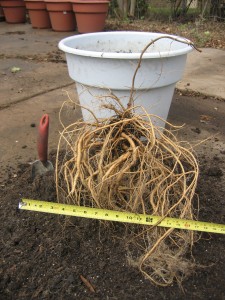
Rhizomes start small, but grow into a “crown” — a twisted mass of underground stem — after a couple years.
—
Related articles
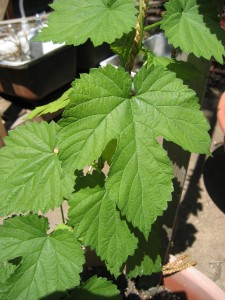
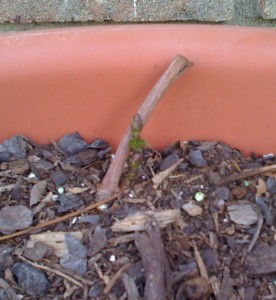
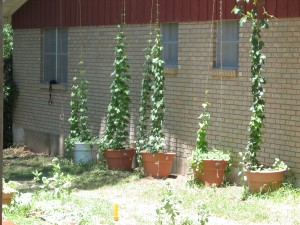

I’m looking forward to your growing season maintenance follow up. Any tips on dealing with Japanese beetles would be much appreciated. They shredded my plants last year.
If you had Japanese beetles last year, they will definitely return. Their grubs will be in your soil. Early in the season, before the hops even sprout, dig around and cultivate the soil (with a hand cultivator) around your hops. Destroy any grubs you find. You can reduce their numbers greatly before they even emerge. Be careful not to damage the hop rhizomes when digging, though.
When “beetle season” arrives, go out in the early morning, when it’s still cool. Spread some old newspapers under your hops, and then shake the bines. Tap the leaves. The beetles will just fall off and will be slow to fly away. Pick them off the paper and drown them in a coffee can filled with water, with a couple drops of dishwashing liquid added. Three or four days in a row of doing this will reduce their numbers to almost nothing (and hopefully spiders or wasps will finish the job).
It seems like a hassle at first, but it really doesn’t take that long each morning, and it’s surprisingly effective.